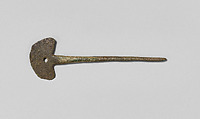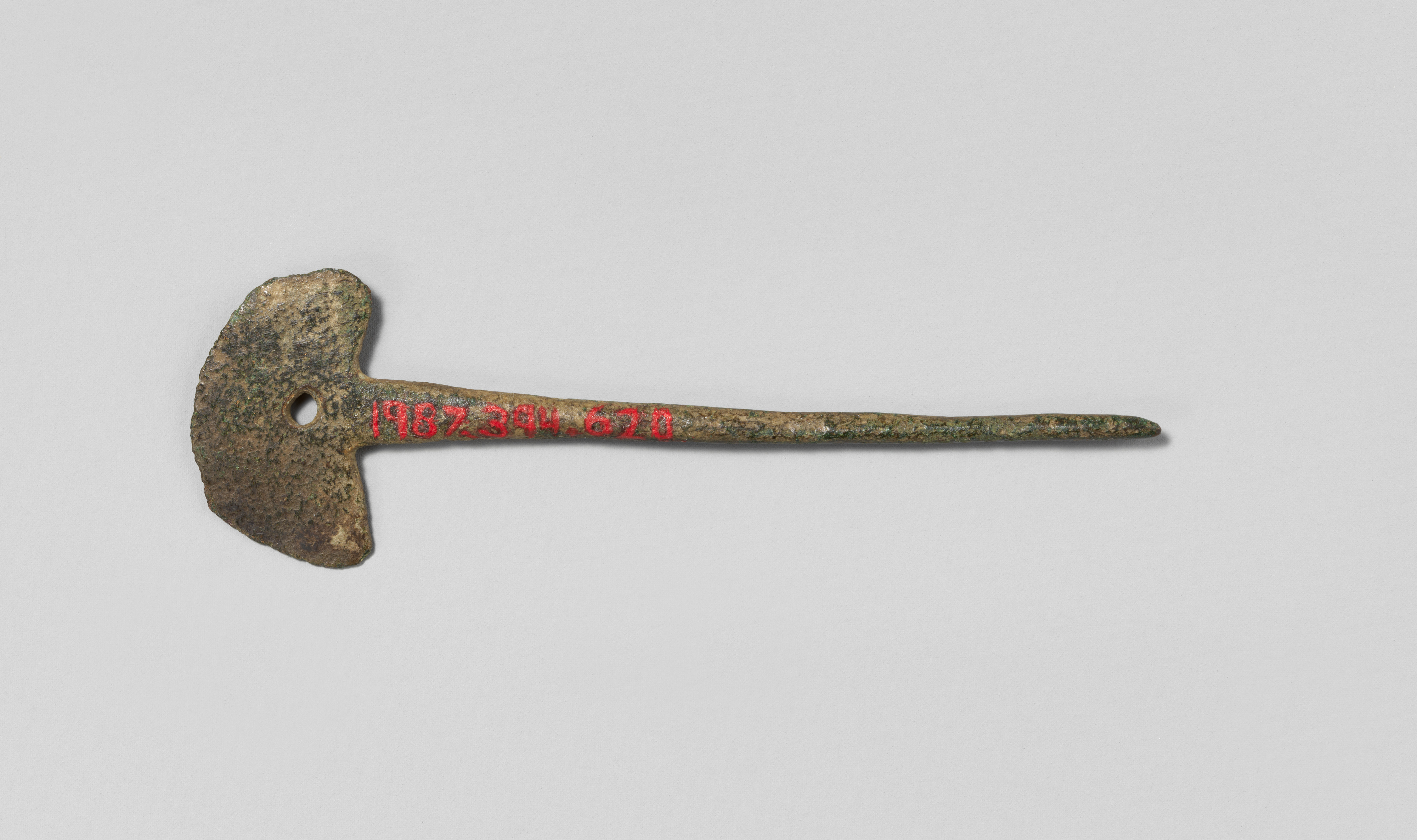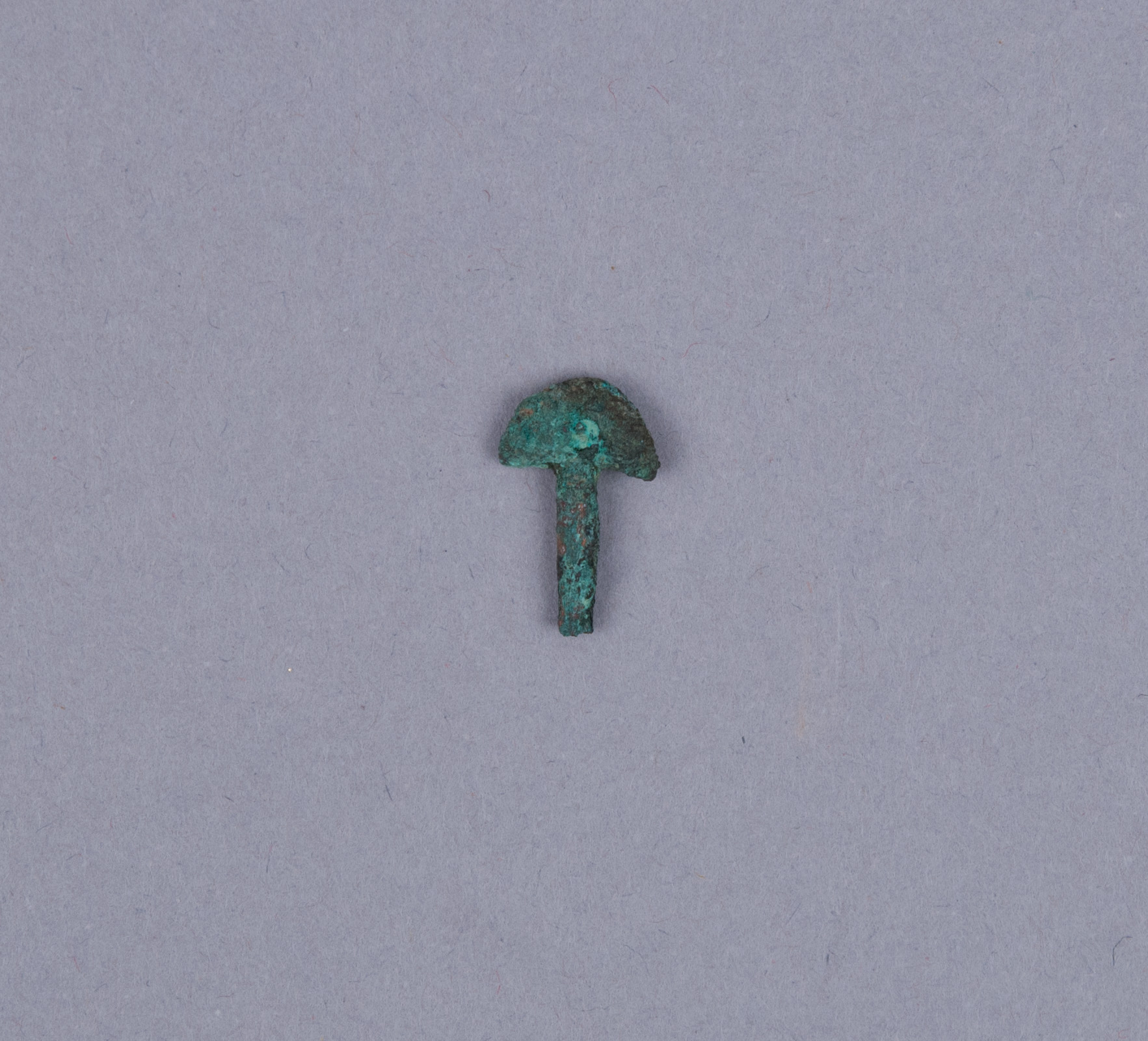Tupu (pin)
Not on view
This metal object is a pin typically referred to as a tupu (also spelled “topo” or “topu”), a Quechua term (“pithu” in Aymara). It is made of copper or an alloy of copper given the green patina on some of the surface. This patina is a product of natural corrosion. Tupus consist of two parts: the head (“cuerpo” or “cabeza” to use the Spanish terms of Fernández 2015, 10) and the stem (“alfiler” or “espiga”). The head of this particular tupu is semi-circular, its lower edges pointing slightly downward. In profile, the head is especially thin. There is a circular perforation at the center of the head, in the lower half. Significantly thicker than the head of the tupu, its stem is broad near the top and then narrows to its end point. The stem features a circular cross section. Besides natural corrosion, the surface shows encrusted soil and pitting. The edges of the head are relatively rough, especially along the top.
To make this object, metalworkers would have cast the metal likely by creating a refractory ceramic mold, shaping clay to create a cavity in the basic form of the tupu. In the process of casting, the metalworkers filled this space with molten metal. After the metal solidified, the workers then removed the refractory material from the cast metal object. Further shaping of the tupu would have been accomplished by chiseling, especially around the edges of the head, with hammering and annealing to thin the head region and to shape the stem.[1] There does not appear to have been major hammering in the head region because the porosity that resulted from the casting is still prevalent on both sides. To make the perforation in the head, metalworkers likely chiseled out the metal in this region after casting.[2]
Tupus of this form have been documented from the highlands of Ecuador to North Central Chile and Northwest Argentina, based on a sample of 89 such tupus (Burger and Salazar 2012, fig. 2.2c). The lack of archaeological provenance or documentation for this object, however, makes it difficult to associate it with a particular cultural context. Across this wide geographic landscape, people, typically women, have worn and wear today tupus or variants of tupus in order to fasten garments. A person may use a pair of tupus to fasten a large cloth (acsu or anaco) that wraps around the body and a third to secure a cloth over the shoulders (lliclla) (e.g., Metropolitan Museum of Art 1995.109). (For more information on the wider history of tupus, please see Metropolitan Museum of Art 64.228.702). In describing an Inca tupu recovered from La Paz similar to the present example, but made of gold and slightly longer (9.4 cm), Fernández (2015, 43) suggests that this form of tupu, with its semicircular head, resembles that of a tumi, a ceremonial knife produced in the central and southern Andes.[3]
One important comparison for this tupu is to those produced within the Inca Empire (ca. A.D. 1400-1533) (a time period also referred to as the Late Horizon) and associated with capac hucha, the ritualized performance of “royal obligation.” In this practice, processions occurred from Cusco to various locations in the Empire leading to the burial of children with a range of materials. The events occurred to mark the expansion of the Empire and to commemorate certain royal occasions. (For more information on capac hucha, please see the Timeline Essay: Capac Hucha as an Inca Assemblage). The children were interred wrapped in textiles that were fastened by tupus. Small metal and shell figurines included in these burial assemblages also were clothed in textiles secured by tupus. Sites of capac hucha are located in present-day Ecuador, Peru, Bolivia, Chile, and Argentina and are typically located on mountain peaks but also found in coastal settings (see McEwan and Silva 1989 on Isla de la Plata, Gibaja et al. 2014 on Choquepujio, Checura 1977 on Cerro Esmeralda, and Schobinger 2001 on Cerro Aconcagua). [4]
The small size of the present example and the shape of its head are similar to many tupus that were used to fasten the textile garments worn by the metal and shell figurines in capac hucha depositions. In the case of an Inca assemblage from the site of Corral Redondo in the Churunga Valley of Peru, a female figurine made of shell was wrapped in a lliclla and adorned with a feather headdress and two tupus of a size and shape similar to those of the present example (King 2016, fig. 5a). [5] Another example was recovered from an Inca context at Huaca de la Luna in Peru (Uceda et al. 2016, 240-241). In this case, there are two silver tupus connected by a textile cord from which hang two Spondylus spp. plaques. The tupus appear to fasten the acsu of a female shell figurine, while a third tupu perforates the two folded halves of the figurine’s lliclla. Compared to the example at the Metropolitan, whose head does not show much hammering after casting, the heads of the tupus from Corral Redondo and Huaca de la Luna are significantly flatter, a feature produced by hammering. Their compositions also differ: copper or a copper alloy for the present example and silver for the others. At Choquepujio (or Choquepukio), in the Cusco Valley of Peru, at least 16 tupus have been recovered from a group of capac hucha depositions (Gibaja et al. 2014). Some of these tupus are relatively larger in size, potentially ornaments for the human body, and others are on the scale of the present example and likely would have adorned figurines (Gibaja et al. 2014).
Two tupus (Field Museum 4363.4 and 4363.5) made of copper alloys and of a similar size and form to the present example were recovered from the capac hucha deposition at Isla de la Plata in Ecuador (see note [6], images 3 and 4, and McEwan and Silva 1989, fig. 14).These were part of a wider assemblage that included two people (noted by the excavators, but not preserved), four metal figurines (akin to objects like Metropolitan Museum of Art 1974.271.8), six larger tupus, and a range of Inca ceramics. It is likely, given their size, that the two similar tupus were once used along with others that were not recovered to fasten garments worn by the metal figurines. The six larger tupus may have secured the clothing of the people who were buried at the site. As the examples from Corral Redondo and especially Huaca de la Luna show, tupus from capac hucha contexts exhibit variation in size, form, technology, composition; thus, not all tupus from capac hucha sites are exactly akin to the present example. Furthermore, tupus may be found in other Inca contexts that are not necessarily related to capac hucha (please see, for example, the tupus in a deposition at the Corikancha in Cusco, Peru discussed in Farrington [2013, 172–73, fig. 7.18]).
At the Inca site of Sacsahuamán near Cusco, the tupus that were recovered are presumed to be larger than the present example is, given that they were associated with human bodies (Andrushko et al. 2006). The excavators distinguished between “pins with a round or semi-circular head” and “small-headed pins,” which they referred to as tupus and alfileres (“pin” in Spanish), respectively. While tupus are usually considered gendered objects, associated with women, in the cemetery of the Suchuna region at Sacsahuamán, ten women and three men were buried with tupus, and eight women and five men were associated with alfileres. This possible rupture in an assumed correlation between the presence of tupus and the presence of women is important to consider, most especially when archaeologists are identifying the person’s sex, which may be different from their gender. As Gero (2001, 24) notes, tupus do not simply “‘map’ women’s movement”; instead, they must be contextualized in order to understand how they participate in a larger construction of gender.
Andrushko et al. (2006, 70) also use tupus as markers of class, comparing burial assemblages between Sacsahuamán and the non-capac hucha contexts at Choquepujio. At the latter site, they consider the people interred were “of lower status” because the items with which they were buried were “small personal items such as tupu pins or refuse items such as small ceramic sherds or obsidian flakes.” While class is a construction and a product of relationships, and therefore cannot necessarily be inferred from the presence or absence of materials, the excavators’ inference is at odds with other archaeological interpretations (see Alconini 2010) in which the presence of tupus is viewed as an indication that people were participating in wider networks of material wealth. Furthermore, the Basque friar Martín de Murúa (2008) wrote between the late 16th century and early 17th century that Inca nobility featured the tupu and the chipana (armband) in their marriages as markers of power.[7]
Finally, another Late Horizon context of tupus is the site of Puruchuco-Huaquerones on the central coast of Peru, near Lima. Excavators identified funerary bundles in which people were wearing tupus at their shoulders, and these tupus were mainly made of silver-copper alloys (Vetter 2007). Similar to the present example, the tupus were cast in a mold that was shaped around the tupu form, and then lightly hammered and annealed around the head and the tip of the stem. Traces of drawing were noted on the stem. Among the tupus I surveyed in published literature and in museum collections, some of those from the Inca contexts of the capac hucha deposition at Choquepujio (n=7) and the Corikancha at Cusco (n=3) are most similar to the present example. Their presence in Inca contexts and their association with figurines suggest one possible context for this tupu—that it may have been used to fasten a garment worn by an Inca figurine, in metal or shell and likely female, and may once have been tied on a cord connecting it with another tupu.
Bryan Cockrell, Curatorial Fellow, Art of Africa, Oceania, and the Americas, 2017 Related Objects: 64.228.606, 1974.271.8, 1995.109
[1] It is possible that they also used drawing to form the stem, a practice that Vetter (2007, 122) notes is documented on the north coast of Peru. Metalworkers may have inserted the metal into fine spaces between rocks, pulling the metal through to the other side, and thinning it. Metallography would be needed to confirm the types and sequence of metallurgical techniques used to make this object.
[2] However, an early study (Mathewson 1915 in Vetter 2007, 124) concluded that the perforation in a tupu from Machu Picchu would have been created in the casting mold and not in the metal after casting.
[3] Flor Becerra was immensely helpful in suggesting I consult the volume by María Soledad Fernández.
[4] Local communities have challenged the excavation and the exhibition of materials from these sites (see Fine-Dare 2009; Politis 2001).
[5] In King 2016, fig. 5a, the tupus are shown inserted into the top edge of the lliclla, and a cord fastens the cloth. As the author notes, the excavators and/or museum staff likely removed the figurine’s adornments and then re-clothed it, potentially changing the ways in which the objects interacted with one another from their original relationships.
[6] This references work that was carried out by Bryan Cockrell and Colin McEwan in collaboration with Ryan Williams, Laure Dussubieux, and other staff of the Field Museum in 2015.
[7] Certainly, the tupus featured in such marriages may create power, wealth, or class in very different ways from the example in the Metropolitan.
Further reading
Alconini, Sonia. “Yampara Households and Communal Evolution in the Southeastern Inka Peripheries.” In Distant Provinces in the Inka Empire: Toward a Deeper Understanding of Inka Imperialism, edited by Sonia Alconini and Michael Malpass, 75-107. Iowa City: University of Iowa Press, 2010.
Andrushko, Valerie A., Elva C. Torres Pino and Viviana Bellifemine. “The Burials at Sacsahuaman and Chokepukio: A Bioarchaeological Case Study of Imperialism from the Capital of the Inca Empire.” Ñawpa Pacha 28 (2006): 63-92, at http://dx.doi.org/10.1179/naw.2006.28.1.005 Checura, Jorge. “Funebria incaica en el cerro Esmeralda (Iquique, I región).” Estudios Atacameños 5 (1977): 125–41.
Farrington, Ian. Cusco: Urbanism and Archaeology in the Inka World. Gainesville: University Press of Florida, 2013.
Fernández Murillo, María Soledad. Prendedores, topos y mujeres. La Paz: Museo Nacional de Etnografía y Folklore, Fundación Cultural del Banco Central de Bolivia, 2015.
Fine-Dare, Kathleen S. “Bodies Unburied, Mummies Displayed: Mourning, Museums, and Identity Politics in the Americas.” In Border Crossings: Transnational Americanist Anthropology, edited by Kathleen S. Fine-Dare and Steven Rubenstein, 67–118. Lincoln: University of Nebraska Press, 2009.
Gero, Joan M. “Field Knots and Ceramic Beaus: Interpreting Gender in the Peruvian Early Intermediate Period.” In Gender in Pre-Hispanic America: A Symposium at Dumbarton Oaks, 12 and 13 October 1996, edited by Cecelia F. Klein, 15-55. Washington, D.C.: Dumbarton Oaks Research Library and Collection, 2001.
Gibaja Oviedo, Arminda M., Gordon F. McEwan, Melissa Chatfield, and Valerie Andrushko. “Informe de las posibles capacochas del asentamiento arqueológico de Choquepujio, Cusco, Perú.” Ñawpa Pacha 34 (2014): 147–75, at http://dx.doi.org/10.1179/0077629714Z.00000000019
King, Heidi. “Further Notes on Corral Redondo, Churunga Valley." Ñawpa Pacha 36, no. 2 (2016): 95–109, at http://dx.doi.org/10.1080/00776297.2016.1239802
Mathewson, Champion Herbert. A Metallographic Description of Some Ancient Peruvian Bronzes from Machu Picchu. New York: 1915.
McEwan, Colin and María Isabel Silva. “Qué fueron a hacer los Incas en la costa central del Ecuador?” In Proceedings: 46th Congreso Internacional de Americanistas: Relaciones interculturales en el área ecuatorial del Pacífico durante la época precolombina, edited by Jean-François Bouchard and Mercedes Guinea, 163-186. Oxford: BAR, 1989.
Murúa, Martín de. Historia general del Piru: Facsimile of J. Paul Getty Museum Ms. Ludwig XIII 16. Los Angeles: Getty Research Institute, [1616] 2008.
Owen, Bruce D. “The Meanings of Metals: The Inca and Regional Contexts of Quotidian Metals from Machu Picchu.” In The 1912 Yale Peruvian Scientific Expedition Collections from Machu Picchu: Metal Artifacts, edited by Richard L. Burger and Lucy C. Salazar, 73-189. New Haven: Yale University Department of Anthropology and the Yale Peabody Museum of Natural History, 2012.
Politis, Gustavo. “On Archaeological Praxis, Gender Bias and Indigenous Peoples in South America.” Journal of Social Archaeology 1, no. 1 (2001): 90–107, at https://doi.org/10.1177/146960530100100107
Schobinger, Juan, ed. El santuario incaico del cerro Aconcagua. Mendoza: EDIUNC-Editorial de la Universidad Nacional de Cuyo, 2001.
Uceda Castillo, Santiago, Ricardo Morales Gamarra, and Elías Mujica Barreda. Huaca de la Luna: Templos y dioses moches. Lima: Fundación Backus and World Monuments Fund, 2016, at https://www.wmf.org/publication/huaca-de-la-luna-moche-temples-and-gods-bilingual
Vetter Parodi, Luisa. “La evolución del tupu en forma y manufactura desde los Incas hasta el siglo XIX.” In Metalurgia en la América antigua: Teoría, arqueología, simbología y tecnología de los metales prehispánicos, edited by Roberto Lleras Pérez, 101–28. Bogotá: Fundación de Investigaciones Arqueológicas Nacionales, Banco de la República, 2007.
Due to rights restrictions, this image cannot be enlarged, viewed at full screen, or downloaded.
This artwork is meant to be viewed from right to left. Scroll left to view more.





